Cadbury Chocolate Marketing Strategy
VerifiedAdded on 2020/05/08
|19
|3473
|59
AI Summary
This assignment requires you to critically analyze Cadbury's marketing strategy in the chocolate industry. You will examine their product portfolio, pricing, distribution, and promotional activities. The analysis should consider their target market segments, competitor landscape, and the broader socio-economic factors influencing the confectionery market. Additionally, you need to evaluate the effectiveness of their current strategies and propose recommendations for future growth.
Contribute Materials
Your contribution can guide someone’s learning journey. Share your
documents today.
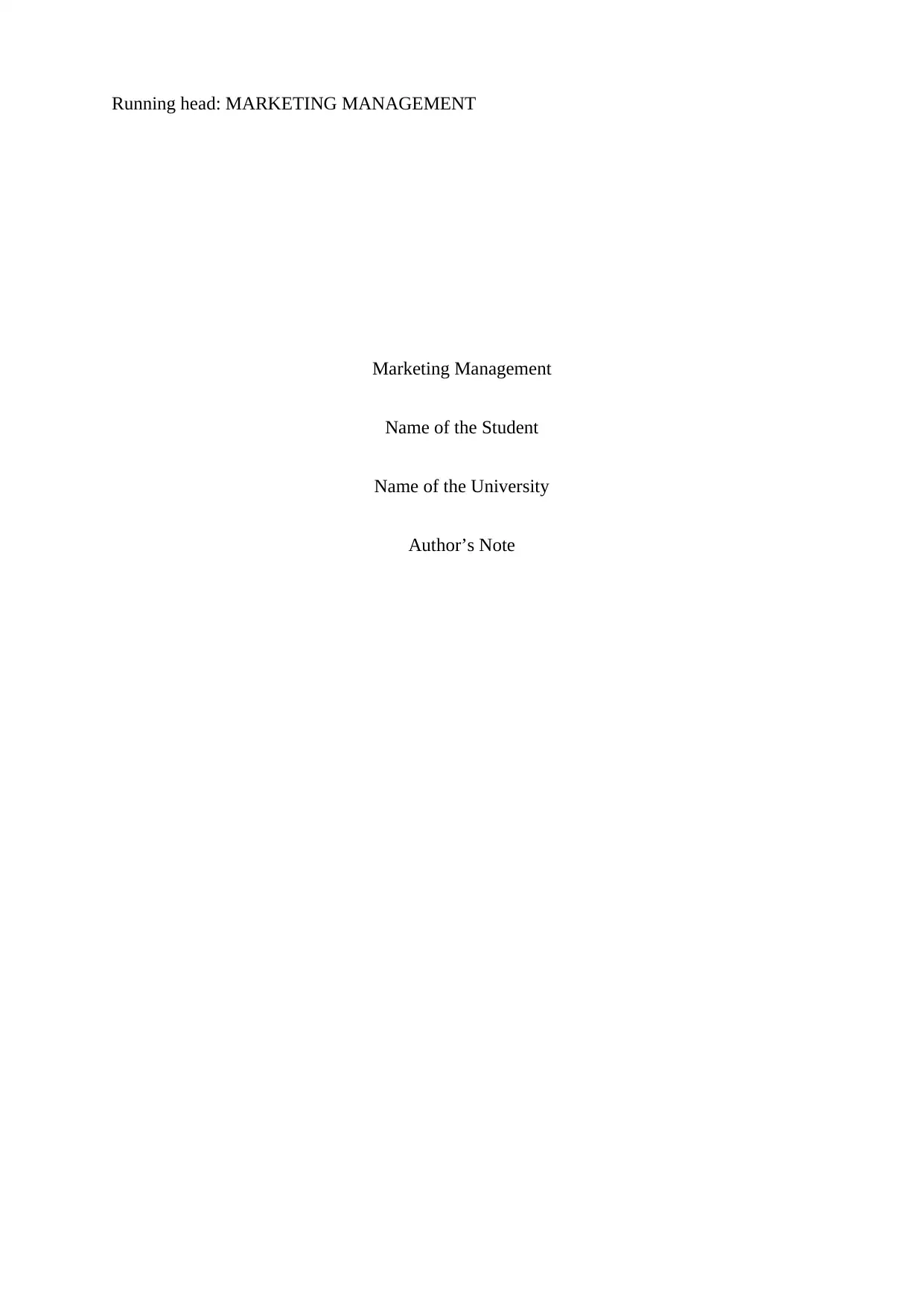
Running head: MARKETING MANAGEMENT
Marketing Management
Name of the Student
Name of the University
Author’s Note
Marketing Management
Name of the Student
Name of the University
Author’s Note
Secure Best Marks with AI Grader
Need help grading? Try our AI Grader for instant feedback on your assignments.
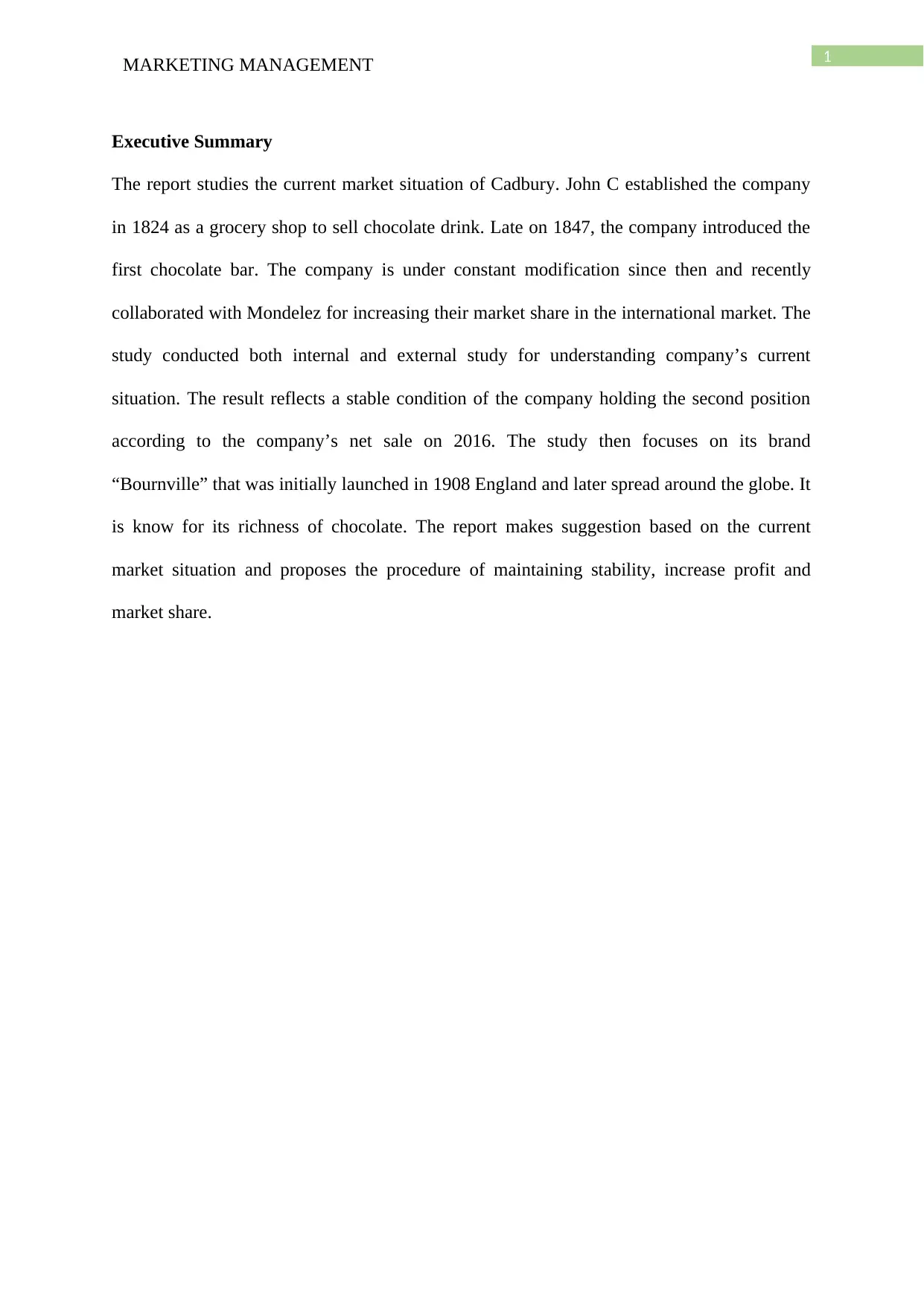
1
MARKETING MANAGEMENT
Executive Summary
The report studies the current market situation of Cadbury. John C established the company
in 1824 as a grocery shop to sell chocolate drink. Late on 1847, the company introduced the
first chocolate bar. The company is under constant modification since then and recently
collaborated with Mondelez for increasing their market share in the international market. The
study conducted both internal and external study for understanding company’s current
situation. The result reflects a stable condition of the company holding the second position
according to the company’s net sale on 2016. The study then focuses on its brand
“Bournville” that was initially launched in 1908 England and later spread around the globe. It
is know for its richness of chocolate. The report makes suggestion based on the current
market situation and proposes the procedure of maintaining stability, increase profit and
market share.
MARKETING MANAGEMENT
Executive Summary
The report studies the current market situation of Cadbury. John C established the company
in 1824 as a grocery shop to sell chocolate drink. Late on 1847, the company introduced the
first chocolate bar. The company is under constant modification since then and recently
collaborated with Mondelez for increasing their market share in the international market. The
study conducted both internal and external study for understanding company’s current
situation. The result reflects a stable condition of the company holding the second position
according to the company’s net sale on 2016. The study then focuses on its brand
“Bournville” that was initially launched in 1908 England and later spread around the globe. It
is know for its richness of chocolate. The report makes suggestion based on the current
market situation and proposes the procedure of maintaining stability, increase profit and
market share.
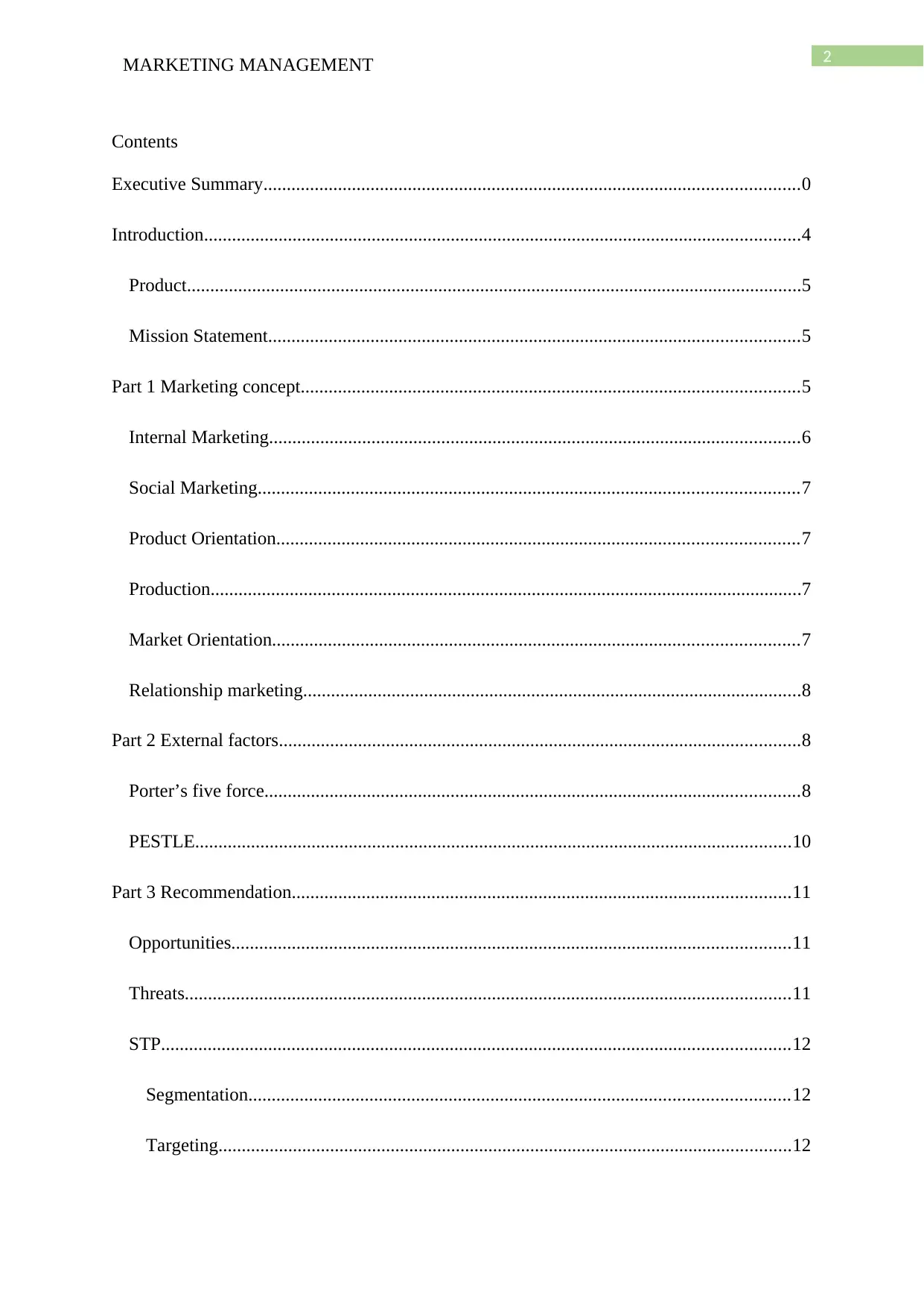
2
MARKETING MANAGEMENT
Contents
Executive Summary...................................................................................................................0
Introduction................................................................................................................................4
Product....................................................................................................................................5
Mission Statement..................................................................................................................5
Part 1 Marketing concept...........................................................................................................5
Internal Marketing..................................................................................................................6
Social Marketing....................................................................................................................7
Product Orientation................................................................................................................7
Production...............................................................................................................................7
Market Orientation.................................................................................................................7
Relationship marketing...........................................................................................................8
Part 2 External factors................................................................................................................8
Porter’s five force...................................................................................................................8
PESTLE................................................................................................................................10
Part 3 Recommendation...........................................................................................................11
Opportunities........................................................................................................................11
Threats..................................................................................................................................11
STP.......................................................................................................................................12
Segmentation....................................................................................................................12
Targeting...........................................................................................................................12
MARKETING MANAGEMENT
Contents
Executive Summary...................................................................................................................0
Introduction................................................................................................................................4
Product....................................................................................................................................5
Mission Statement..................................................................................................................5
Part 1 Marketing concept...........................................................................................................5
Internal Marketing..................................................................................................................6
Social Marketing....................................................................................................................7
Product Orientation................................................................................................................7
Production...............................................................................................................................7
Market Orientation.................................................................................................................7
Relationship marketing...........................................................................................................8
Part 2 External factors................................................................................................................8
Porter’s five force...................................................................................................................8
PESTLE................................................................................................................................10
Part 3 Recommendation...........................................................................................................11
Opportunities........................................................................................................................11
Threats..................................................................................................................................11
STP.......................................................................................................................................12
Segmentation....................................................................................................................12
Targeting...........................................................................................................................12
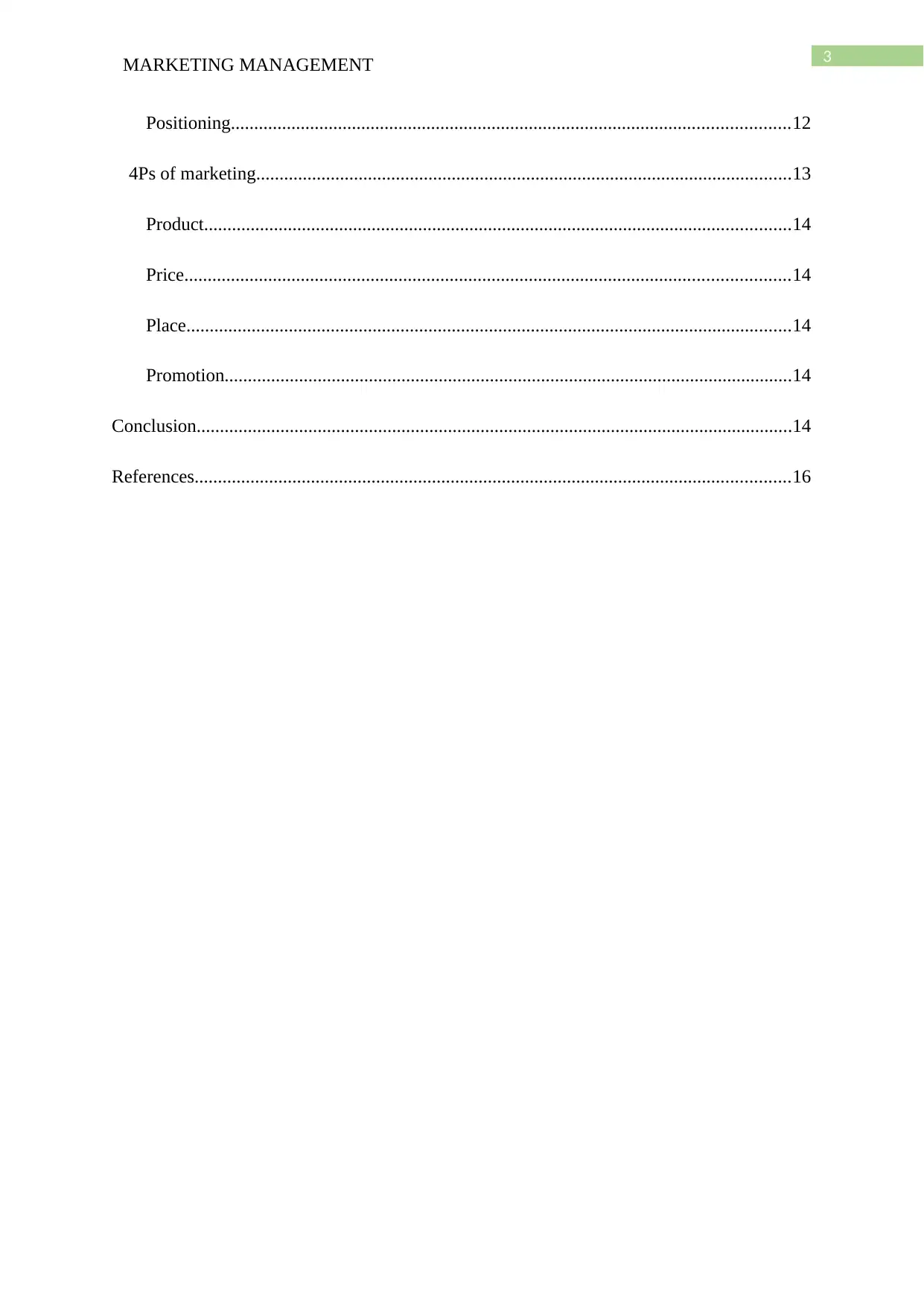
3
MARKETING MANAGEMENT
Positioning........................................................................................................................12
4Ps of marketing...................................................................................................................13
Product..............................................................................................................................14
Price..................................................................................................................................14
Place..................................................................................................................................14
Promotion..........................................................................................................................14
Conclusion................................................................................................................................14
References................................................................................................................................16
MARKETING MANAGEMENT
Positioning........................................................................................................................12
4Ps of marketing...................................................................................................................13
Product..............................................................................................................................14
Price..................................................................................................................................14
Place..................................................................................................................................14
Promotion..........................................................................................................................14
Conclusion................................................................................................................................14
References................................................................................................................................16
Secure Best Marks with AI Grader
Need help grading? Try our AI Grader for instant feedback on your assignments.
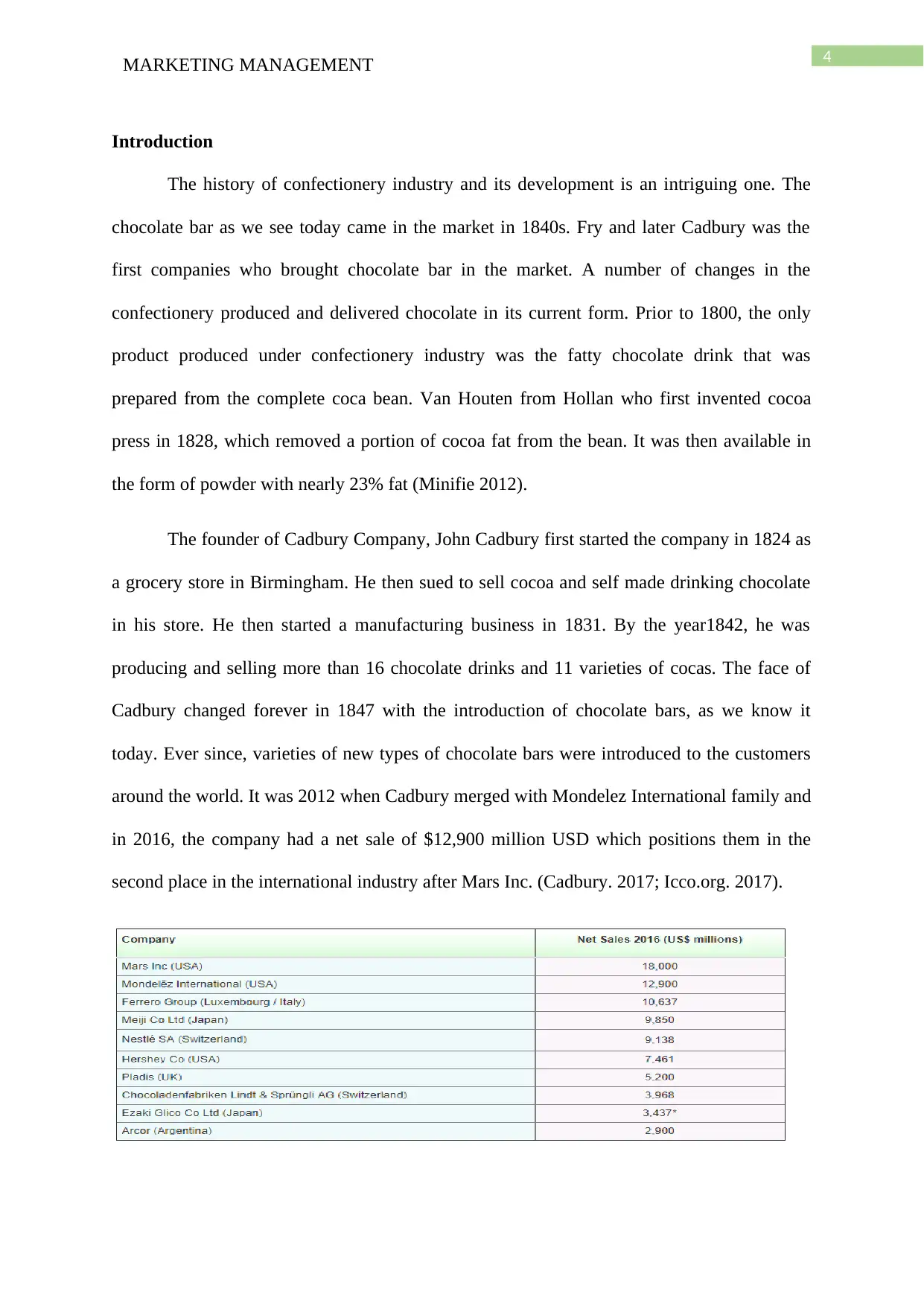
4
MARKETING MANAGEMENT
Introduction
The history of confectionery industry and its development is an intriguing one. The
chocolate bar as we see today came in the market in 1840s. Fry and later Cadbury was the
first companies who brought chocolate bar in the market. A number of changes in the
confectionery produced and delivered chocolate in its current form. Prior to 1800, the only
product produced under confectionery industry was the fatty chocolate drink that was
prepared from the complete coca bean. Van Houten from Hollan who first invented cocoa
press in 1828, which removed a portion of cocoa fat from the bean. It was then available in
the form of powder with nearly 23% fat (Minifie 2012).
The founder of Cadbury Company, John Cadbury first started the company in 1824 as
a grocery store in Birmingham. He then sued to sell cocoa and self made drinking chocolate
in his store. He then started a manufacturing business in 1831. By the year1842, he was
producing and selling more than 16 chocolate drinks and 11 varieties of cocas. The face of
Cadbury changed forever in 1847 with the introduction of chocolate bars, as we know it
today. Ever since, varieties of new types of chocolate bars were introduced to the customers
around the world. It was 2012 when Cadbury merged with Mondelez International family and
in 2016, the company had a net sale of $12,900 million USD which positions them in the
second place in the international industry after Mars Inc. (Cadbury. 2017; Icco.org. 2017).
MARKETING MANAGEMENT
Introduction
The history of confectionery industry and its development is an intriguing one. The
chocolate bar as we see today came in the market in 1840s. Fry and later Cadbury was the
first companies who brought chocolate bar in the market. A number of changes in the
confectionery produced and delivered chocolate in its current form. Prior to 1800, the only
product produced under confectionery industry was the fatty chocolate drink that was
prepared from the complete coca bean. Van Houten from Hollan who first invented cocoa
press in 1828, which removed a portion of cocoa fat from the bean. It was then available in
the form of powder with nearly 23% fat (Minifie 2012).
The founder of Cadbury Company, John Cadbury first started the company in 1824 as
a grocery store in Birmingham. He then sued to sell cocoa and self made drinking chocolate
in his store. He then started a manufacturing business in 1831. By the year1842, he was
producing and selling more than 16 chocolate drinks and 11 varieties of cocas. The face of
Cadbury changed forever in 1847 with the introduction of chocolate bars, as we know it
today. Ever since, varieties of new types of chocolate bars were introduced to the customers
around the world. It was 2012 when Cadbury merged with Mondelez International family and
in 2016, the company had a net sale of $12,900 million USD which positions them in the
second place in the international industry after Mars Inc. (Cadbury. 2017; Icco.org. 2017).
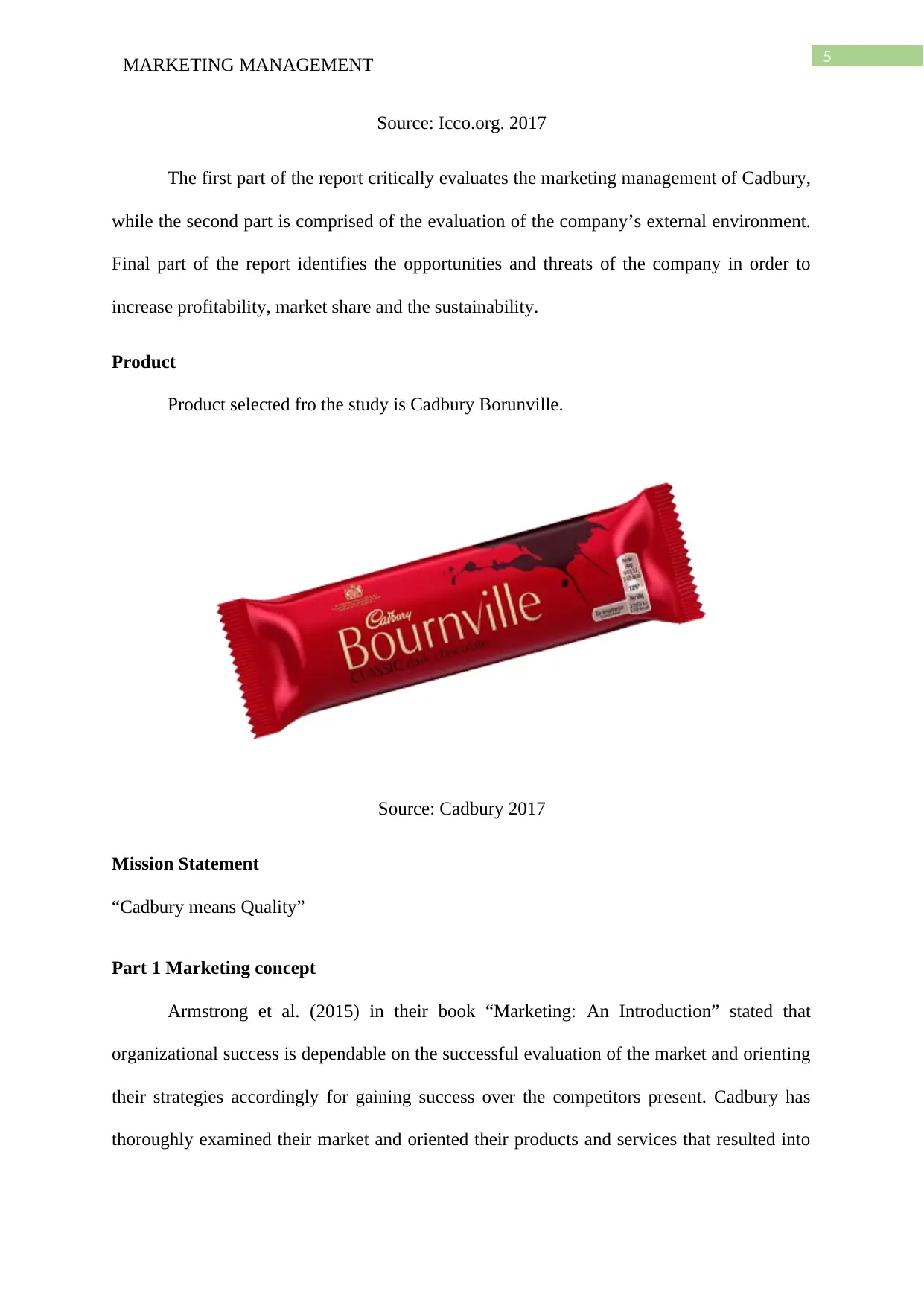
5
MARKETING MANAGEMENT
Source: Icco.org. 2017
The first part of the report critically evaluates the marketing management of Cadbury,
while the second part is comprised of the evaluation of the company’s external environment.
Final part of the report identifies the opportunities and threats of the company in order to
increase profitability, market share and the sustainability.
Product
Product selected fro the study is Cadbury Borunville.
Source: Cadbury 2017
Mission Statement
“Cadbury means Quality”
Part 1 Marketing concept
Armstrong et al. (2015) in their book “Marketing: An Introduction” stated that
organizational success is dependable on the successful evaluation of the market and orienting
their strategies accordingly for gaining success over the competitors present. Cadbury has
thoroughly examined their market and oriented their products and services that resulted into
MARKETING MANAGEMENT
Source: Icco.org. 2017
The first part of the report critically evaluates the marketing management of Cadbury,
while the second part is comprised of the evaluation of the company’s external environment.
Final part of the report identifies the opportunities and threats of the company in order to
increase profitability, market share and the sustainability.
Product
Product selected fro the study is Cadbury Borunville.
Source: Cadbury 2017
Mission Statement
“Cadbury means Quality”
Part 1 Marketing concept
Armstrong et al. (2015) in their book “Marketing: An Introduction” stated that
organizational success is dependable on the successful evaluation of the market and orienting
their strategies accordingly for gaining success over the competitors present. Cadbury has
thoroughly examined their market and oriented their products and services that resulted into
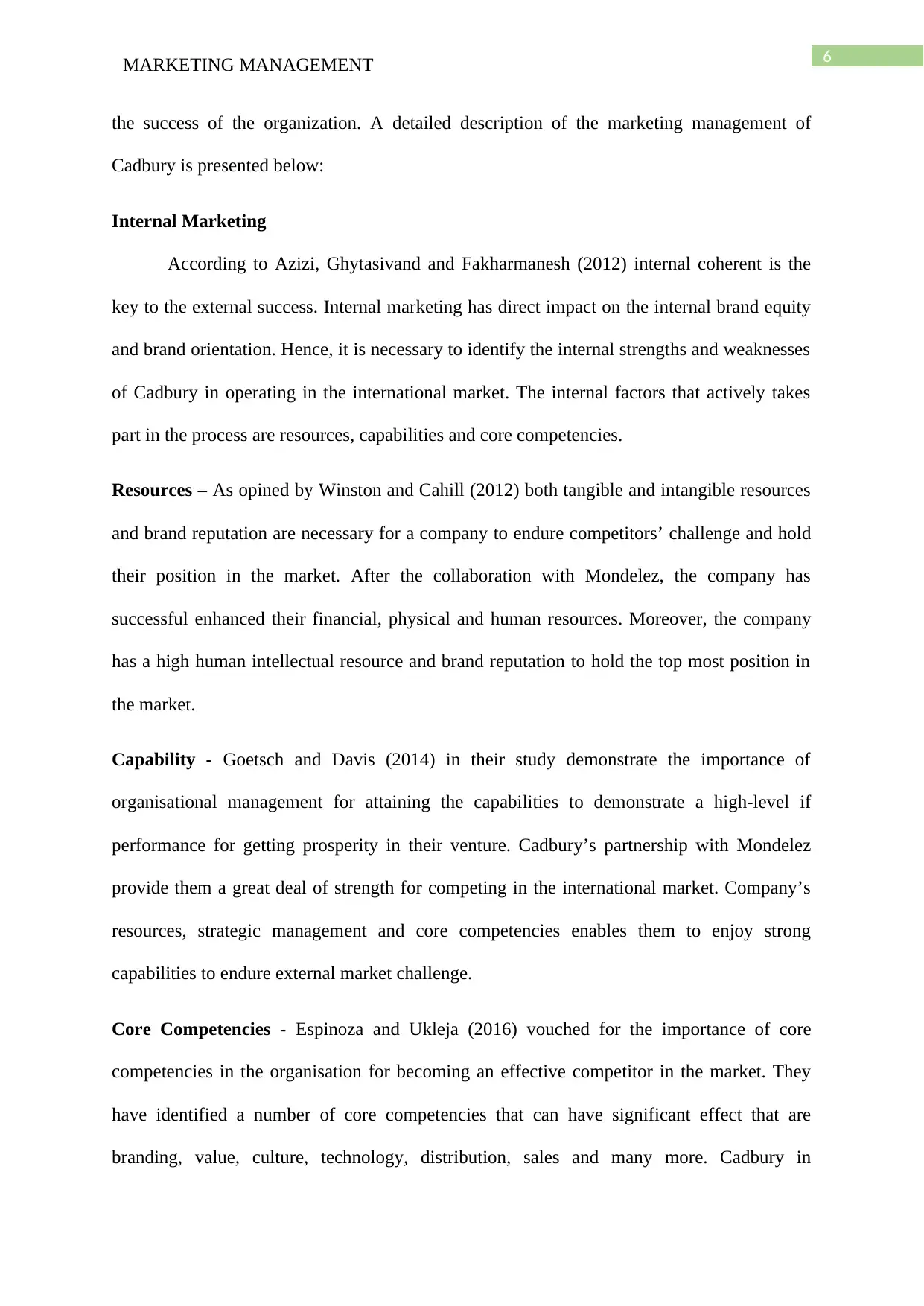
6
MARKETING MANAGEMENT
the success of the organization. A detailed description of the marketing management of
Cadbury is presented below:
Internal Marketing
According to Azizi, Ghytasivand and Fakharmanesh (2012) internal coherent is the
key to the external success. Internal marketing has direct impact on the internal brand equity
and brand orientation. Hence, it is necessary to identify the internal strengths and weaknesses
of Cadbury in operating in the international market. The internal factors that actively takes
part in the process are resources, capabilities and core competencies.
Resources – As opined by Winston and Cahill (2012) both tangible and intangible resources
and brand reputation are necessary for a company to endure competitors’ challenge and hold
their position in the market. After the collaboration with Mondelez, the company has
successful enhanced their financial, physical and human resources. Moreover, the company
has a high human intellectual resource and brand reputation to hold the top most position in
the market.
Capability - Goetsch and Davis (2014) in their study demonstrate the importance of
organisational management for attaining the capabilities to demonstrate a high-level if
performance for getting prosperity in their venture. Cadbury’s partnership with Mondelez
provide them a great deal of strength for competing in the international market. Company’s
resources, strategic management and core competencies enables them to enjoy strong
capabilities to endure external market challenge.
Core Competencies - Espinoza and Ukleja (2016) vouched for the importance of core
competencies in the organisation for becoming an effective competitor in the market. They
have identified a number of core competencies that can have significant effect that are
branding, value, culture, technology, distribution, sales and many more. Cadbury in
MARKETING MANAGEMENT
the success of the organization. A detailed description of the marketing management of
Cadbury is presented below:
Internal Marketing
According to Azizi, Ghytasivand and Fakharmanesh (2012) internal coherent is the
key to the external success. Internal marketing has direct impact on the internal brand equity
and brand orientation. Hence, it is necessary to identify the internal strengths and weaknesses
of Cadbury in operating in the international market. The internal factors that actively takes
part in the process are resources, capabilities and core competencies.
Resources – As opined by Winston and Cahill (2012) both tangible and intangible resources
and brand reputation are necessary for a company to endure competitors’ challenge and hold
their position in the market. After the collaboration with Mondelez, the company has
successful enhanced their financial, physical and human resources. Moreover, the company
has a high human intellectual resource and brand reputation to hold the top most position in
the market.
Capability - Goetsch and Davis (2014) in their study demonstrate the importance of
organisational management for attaining the capabilities to demonstrate a high-level if
performance for getting prosperity in their venture. Cadbury’s partnership with Mondelez
provide them a great deal of strength for competing in the international market. Company’s
resources, strategic management and core competencies enables them to enjoy strong
capabilities to endure external market challenge.
Core Competencies - Espinoza and Ukleja (2016) vouched for the importance of core
competencies in the organisation for becoming an effective competitor in the market. They
have identified a number of core competencies that can have significant effect that are
branding, value, culture, technology, distribution, sales and many more. Cadbury in
Paraphrase This Document
Need a fresh take? Get an instant paraphrase of this document with our AI Paraphraser
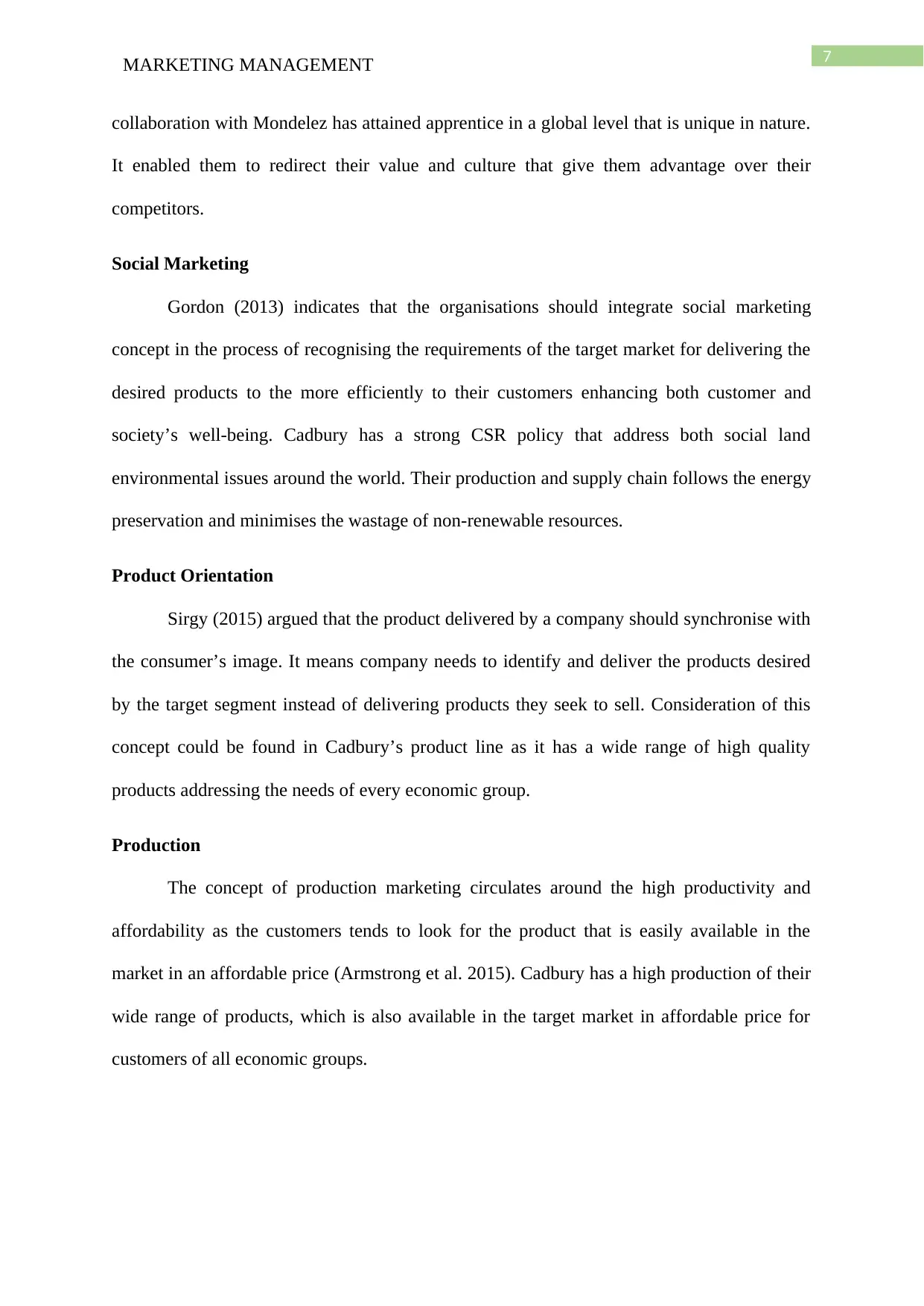
7
MARKETING MANAGEMENT
collaboration with Mondelez has attained apprentice in a global level that is unique in nature.
It enabled them to redirect their value and culture that give them advantage over their
competitors.
Social Marketing
Gordon (2013) indicates that the organisations should integrate social marketing
concept in the process of recognising the requirements of the target market for delivering the
desired products to the more efficiently to their customers enhancing both customer and
society’s well-being. Cadbury has a strong CSR policy that address both social land
environmental issues around the world. Their production and supply chain follows the energy
preservation and minimises the wastage of non-renewable resources.
Product Orientation
Sirgy (2015) argued that the product delivered by a company should synchronise with
the consumer’s image. It means company needs to identify and deliver the products desired
by the target segment instead of delivering products they seek to sell. Consideration of this
concept could be found in Cadbury’s product line as it has a wide range of high quality
products addressing the needs of every economic group.
Production
The concept of production marketing circulates around the high productivity and
affordability as the customers tends to look for the product that is easily available in the
market in an affordable price (Armstrong et al. 2015). Cadbury has a high production of their
wide range of products, which is also available in the target market in affordable price for
customers of all economic groups.
MARKETING MANAGEMENT
collaboration with Mondelez has attained apprentice in a global level that is unique in nature.
It enabled them to redirect their value and culture that give them advantage over their
competitors.
Social Marketing
Gordon (2013) indicates that the organisations should integrate social marketing
concept in the process of recognising the requirements of the target market for delivering the
desired products to the more efficiently to their customers enhancing both customer and
society’s well-being. Cadbury has a strong CSR policy that address both social land
environmental issues around the world. Their production and supply chain follows the energy
preservation and minimises the wastage of non-renewable resources.
Product Orientation
Sirgy (2015) argued that the product delivered by a company should synchronise with
the consumer’s image. It means company needs to identify and deliver the products desired
by the target segment instead of delivering products they seek to sell. Consideration of this
concept could be found in Cadbury’s product line as it has a wide range of high quality
products addressing the needs of every economic group.
Production
The concept of production marketing circulates around the high productivity and
affordability as the customers tends to look for the product that is easily available in the
market in an affordable price (Armstrong et al. 2015). Cadbury has a high production of their
wide range of products, which is also available in the target market in affordable price for
customers of all economic groups.
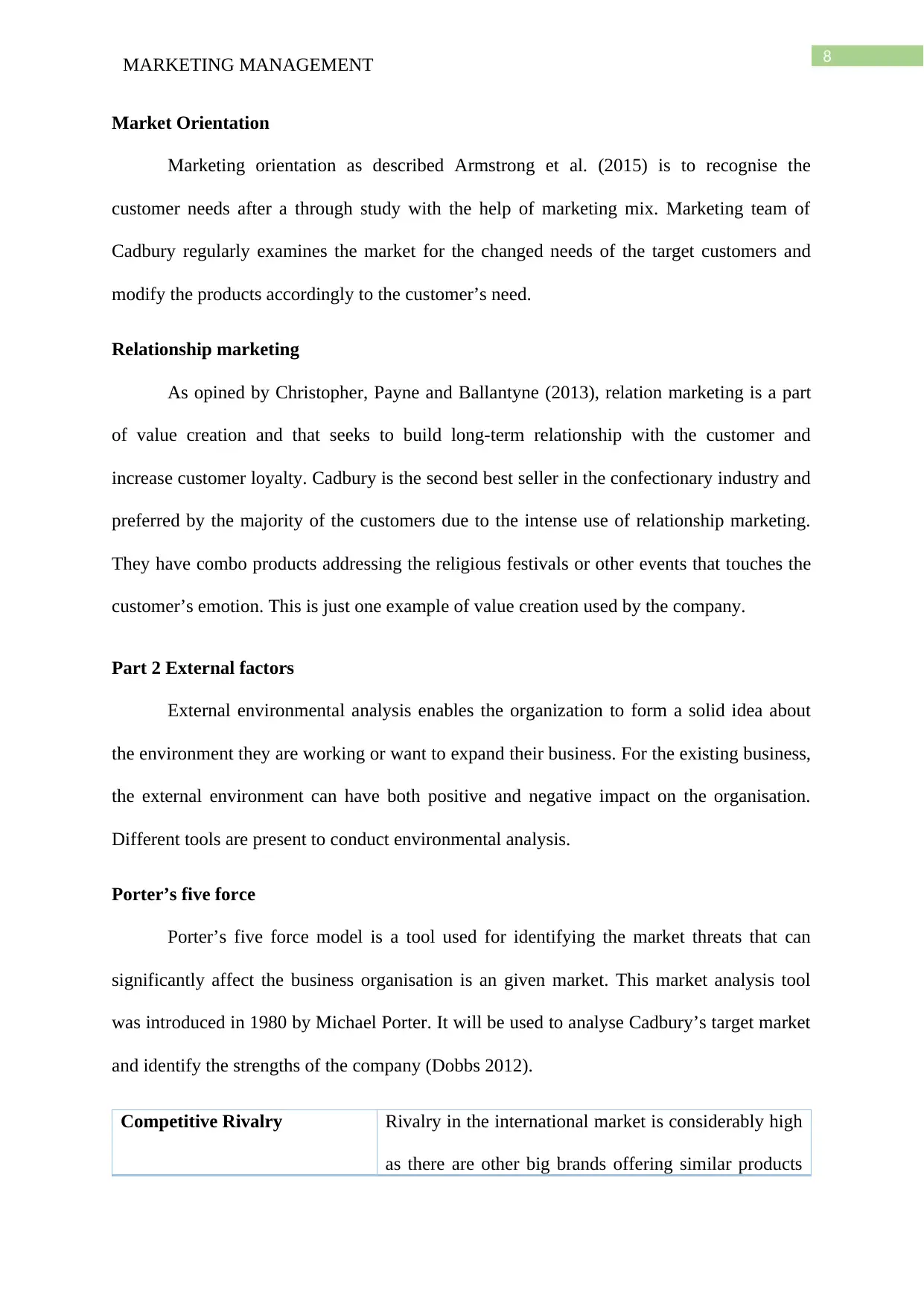
8
MARKETING MANAGEMENT
Market Orientation
Marketing orientation as described Armstrong et al. (2015) is to recognise the
customer needs after a through study with the help of marketing mix. Marketing team of
Cadbury regularly examines the market for the changed needs of the target customers and
modify the products accordingly to the customer’s need.
Relationship marketing
As opined by Christopher, Payne and Ballantyne (2013), relation marketing is a part
of value creation and that seeks to build long-term relationship with the customer and
increase customer loyalty. Cadbury is the second best seller in the confectionary industry and
preferred by the majority of the customers due to the intense use of relationship marketing.
They have combo products addressing the religious festivals or other events that touches the
customer’s emotion. This is just one example of value creation used by the company.
Part 2 External factors
External environmental analysis enables the organization to form a solid idea about
the environment they are working or want to expand their business. For the existing business,
the external environment can have both positive and negative impact on the organisation.
Different tools are present to conduct environmental analysis.
Porter’s five force
Porter’s five force model is a tool used for identifying the market threats that can
significantly affect the business organisation is an given market. This market analysis tool
was introduced in 1980 by Michael Porter. It will be used to analyse Cadbury’s target market
and identify the strengths of the company (Dobbs 2012).
Competitive Rivalry Rivalry in the international market is considerably high
as there are other big brands offering similar products
MARKETING MANAGEMENT
Market Orientation
Marketing orientation as described Armstrong et al. (2015) is to recognise the
customer needs after a through study with the help of marketing mix. Marketing team of
Cadbury regularly examines the market for the changed needs of the target customers and
modify the products accordingly to the customer’s need.
Relationship marketing
As opined by Christopher, Payne and Ballantyne (2013), relation marketing is a part
of value creation and that seeks to build long-term relationship with the customer and
increase customer loyalty. Cadbury is the second best seller in the confectionary industry and
preferred by the majority of the customers due to the intense use of relationship marketing.
They have combo products addressing the religious festivals or other events that touches the
customer’s emotion. This is just one example of value creation used by the company.
Part 2 External factors
External environmental analysis enables the organization to form a solid idea about
the environment they are working or want to expand their business. For the existing business,
the external environment can have both positive and negative impact on the organisation.
Different tools are present to conduct environmental analysis.
Porter’s five force
Porter’s five force model is a tool used for identifying the market threats that can
significantly affect the business organisation is an given market. This market analysis tool
was introduced in 1980 by Michael Porter. It will be used to analyse Cadbury’s target market
and identify the strengths of the company (Dobbs 2012).
Competitive Rivalry Rivalry in the international market is considerably high
as there are other big brands offering similar products
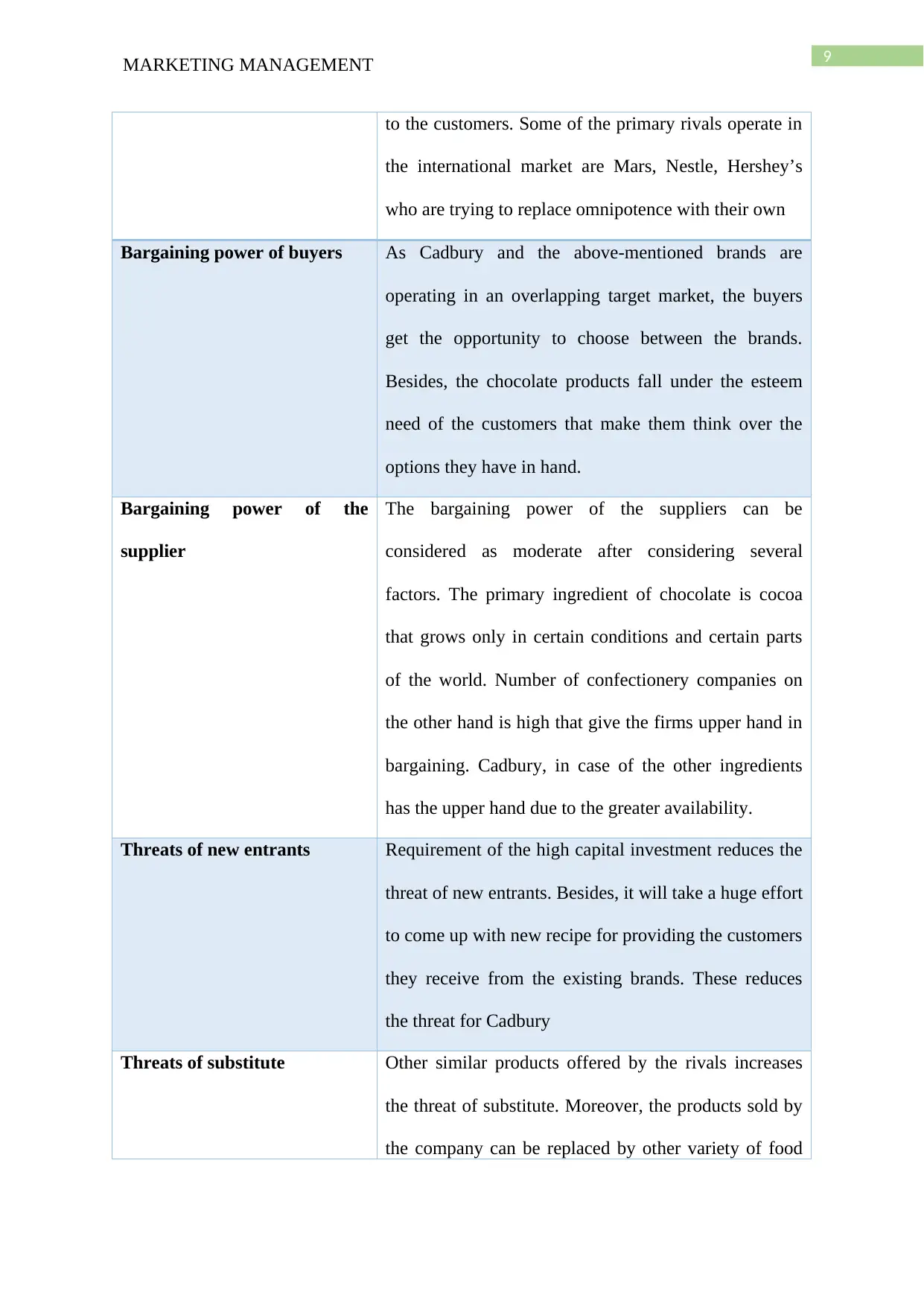
9
MARKETING MANAGEMENT
to the customers. Some of the primary rivals operate in
the international market are Mars, Nestle, Hershey’s
who are trying to replace omnipotence with their own
Bargaining power of buyers As Cadbury and the above-mentioned brands are
operating in an overlapping target market, the buyers
get the opportunity to choose between the brands.
Besides, the chocolate products fall under the esteem
need of the customers that make them think over the
options they have in hand.
Bargaining power of the
supplier
The bargaining power of the suppliers can be
considered as moderate after considering several
factors. The primary ingredient of chocolate is cocoa
that grows only in certain conditions and certain parts
of the world. Number of confectionery companies on
the other hand is high that give the firms upper hand in
bargaining. Cadbury, in case of the other ingredients
has the upper hand due to the greater availability.
Threats of new entrants Requirement of the high capital investment reduces the
threat of new entrants. Besides, it will take a huge effort
to come up with new recipe for providing the customers
they receive from the existing brands. These reduces
the threat for Cadbury
Threats of substitute Other similar products offered by the rivals increases
the threat of substitute. Moreover, the products sold by
the company can be replaced by other variety of food
MARKETING MANAGEMENT
to the customers. Some of the primary rivals operate in
the international market are Mars, Nestle, Hershey’s
who are trying to replace omnipotence with their own
Bargaining power of buyers As Cadbury and the above-mentioned brands are
operating in an overlapping target market, the buyers
get the opportunity to choose between the brands.
Besides, the chocolate products fall under the esteem
need of the customers that make them think over the
options they have in hand.
Bargaining power of the
supplier
The bargaining power of the suppliers can be
considered as moderate after considering several
factors. The primary ingredient of chocolate is cocoa
that grows only in certain conditions and certain parts
of the world. Number of confectionery companies on
the other hand is high that give the firms upper hand in
bargaining. Cadbury, in case of the other ingredients
has the upper hand due to the greater availability.
Threats of new entrants Requirement of the high capital investment reduces the
threat of new entrants. Besides, it will take a huge effort
to come up with new recipe for providing the customers
they receive from the existing brands. These reduces
the threat for Cadbury
Threats of substitute Other similar products offered by the rivals increases
the threat of substitute. Moreover, the products sold by
the company can be replaced by other variety of food
Secure Best Marks with AI Grader
Need help grading? Try our AI Grader for instant feedback on your assignments.
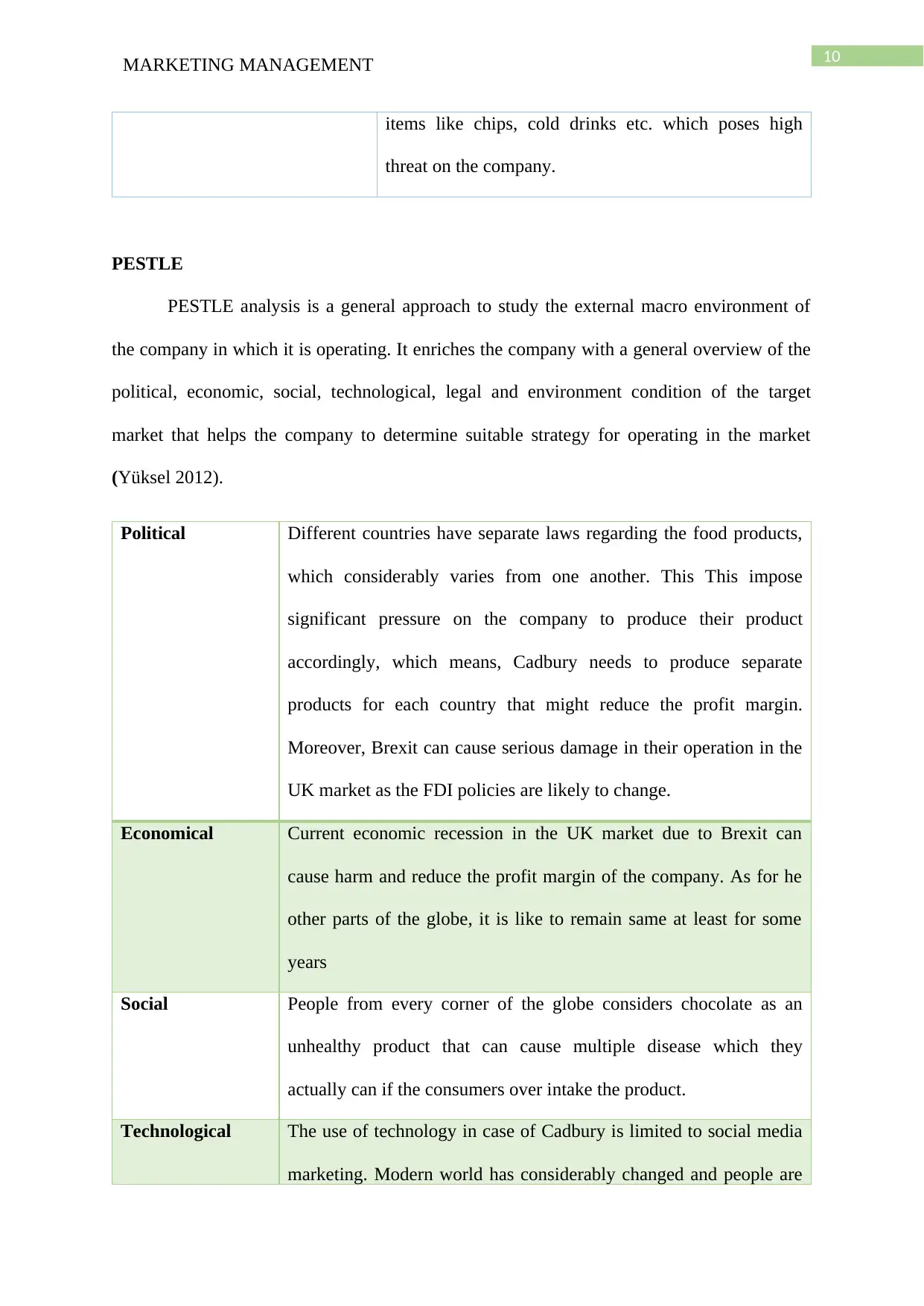
10
MARKETING MANAGEMENT
items like chips, cold drinks etc. which poses high
threat on the company.
PESTLE
PESTLE analysis is a general approach to study the external macro environment of
the company in which it is operating. It enriches the company with a general overview of the
political, economic, social, technological, legal and environment condition of the target
market that helps the company to determine suitable strategy for operating in the market
(Yüksel 2012).
Political Different countries have separate laws regarding the food products,
which considerably varies from one another. This This impose
significant pressure on the company to produce their product
accordingly, which means, Cadbury needs to produce separate
products for each country that might reduce the profit margin.
Moreover, Brexit can cause serious damage in their operation in the
UK market as the FDI policies are likely to change.
Economical Current economic recession in the UK market due to Brexit can
cause harm and reduce the profit margin of the company. As for he
other parts of the globe, it is like to remain same at least for some
years
Social People from every corner of the globe considers chocolate as an
unhealthy product that can cause multiple disease which they
actually can if the consumers over intake the product.
Technological The use of technology in case of Cadbury is limited to social media
marketing. Modern world has considerably changed and people are
MARKETING MANAGEMENT
items like chips, cold drinks etc. which poses high
threat on the company.
PESTLE
PESTLE analysis is a general approach to study the external macro environment of
the company in which it is operating. It enriches the company with a general overview of the
political, economic, social, technological, legal and environment condition of the target
market that helps the company to determine suitable strategy for operating in the market
(Yüksel 2012).
Political Different countries have separate laws regarding the food products,
which considerably varies from one another. This This impose
significant pressure on the company to produce their product
accordingly, which means, Cadbury needs to produce separate
products for each country that might reduce the profit margin.
Moreover, Brexit can cause serious damage in their operation in the
UK market as the FDI policies are likely to change.
Economical Current economic recession in the UK market due to Brexit can
cause harm and reduce the profit margin of the company. As for he
other parts of the globe, it is like to remain same at least for some
years
Social People from every corner of the globe considers chocolate as an
unhealthy product that can cause multiple disease which they
actually can if the consumers over intake the product.
Technological The use of technology in case of Cadbury is limited to social media
marketing. Modern world has considerably changed and people are
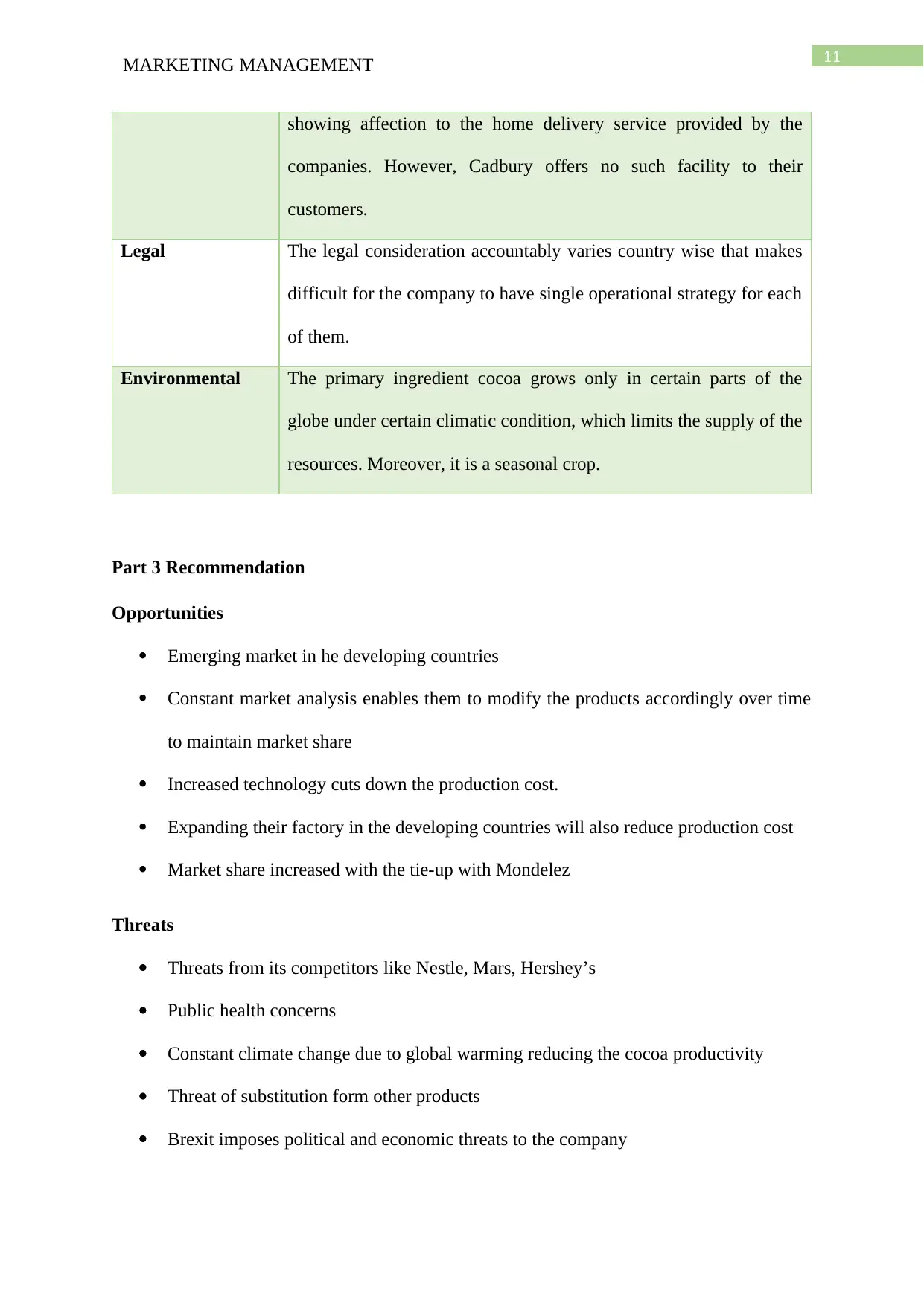
11
MARKETING MANAGEMENT
showing affection to the home delivery service provided by the
companies. However, Cadbury offers no such facility to their
customers.
Legal The legal consideration accountably varies country wise that makes
difficult for the company to have single operational strategy for each
of them.
Environmental The primary ingredient cocoa grows only in certain parts of the
globe under certain climatic condition, which limits the supply of the
resources. Moreover, it is a seasonal crop.
Part 3 Recommendation
Opportunities
Emerging market in he developing countries
Constant market analysis enables them to modify the products accordingly over time
to maintain market share
Increased technology cuts down the production cost.
Expanding their factory in the developing countries will also reduce production cost
Market share increased with the tie-up with Mondelez
Threats
Threats from its competitors like Nestle, Mars, Hershey’s
Public health concerns
Constant climate change due to global warming reducing the cocoa productivity
Threat of substitution form other products
Brexit imposes political and economic threats to the company
MARKETING MANAGEMENT
showing affection to the home delivery service provided by the
companies. However, Cadbury offers no such facility to their
customers.
Legal The legal consideration accountably varies country wise that makes
difficult for the company to have single operational strategy for each
of them.
Environmental The primary ingredient cocoa grows only in certain parts of the
globe under certain climatic condition, which limits the supply of the
resources. Moreover, it is a seasonal crop.
Part 3 Recommendation
Opportunities
Emerging market in he developing countries
Constant market analysis enables them to modify the products accordingly over time
to maintain market share
Increased technology cuts down the production cost.
Expanding their factory in the developing countries will also reduce production cost
Market share increased with the tie-up with Mondelez
Threats
Threats from its competitors like Nestle, Mars, Hershey’s
Public health concerns
Constant climate change due to global warming reducing the cocoa productivity
Threat of substitution form other products
Brexit imposes political and economic threats to the company
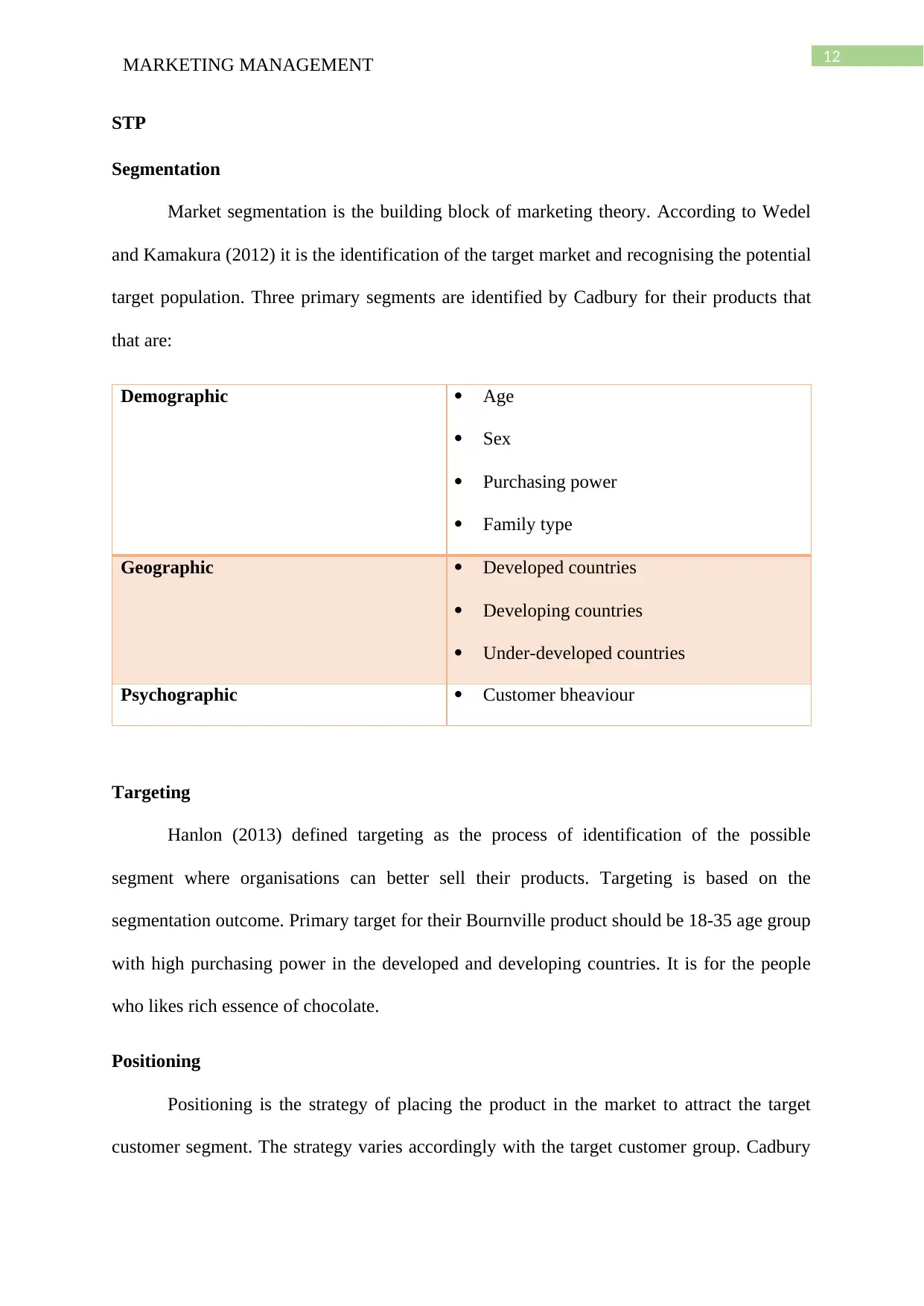
12
MARKETING MANAGEMENT
STP
Segmentation
Market segmentation is the building block of marketing theory. According to Wedel
and Kamakura (2012) it is the identification of the target market and recognising the potential
target population. Three primary segments are identified by Cadbury for their products that
that are:
Demographic Age
Sex
Purchasing power
Family type
Geographic Developed countries
Developing countries
Under-developed countries
Psychographic Customer bheaviour
Targeting
Hanlon (2013) defined targeting as the process of identification of the possible
segment where organisations can better sell their products. Targeting is based on the
segmentation outcome. Primary target for their Bournville product should be 18-35 age group
with high purchasing power in the developed and developing countries. It is for the people
who likes rich essence of chocolate.
Positioning
Positioning is the strategy of placing the product in the market to attract the target
customer segment. The strategy varies accordingly with the target customer group. Cadbury
MARKETING MANAGEMENT
STP
Segmentation
Market segmentation is the building block of marketing theory. According to Wedel
and Kamakura (2012) it is the identification of the target market and recognising the potential
target population. Three primary segments are identified by Cadbury for their products that
that are:
Demographic Age
Sex
Purchasing power
Family type
Geographic Developed countries
Developing countries
Under-developed countries
Psychographic Customer bheaviour
Targeting
Hanlon (2013) defined targeting as the process of identification of the possible
segment where organisations can better sell their products. Targeting is based on the
segmentation outcome. Primary target for their Bournville product should be 18-35 age group
with high purchasing power in the developed and developing countries. It is for the people
who likes rich essence of chocolate.
Positioning
Positioning is the strategy of placing the product in the market to attract the target
customer segment. The strategy varies accordingly with the target customer group. Cadbury
Paraphrase This Document
Need a fresh take? Get an instant paraphrase of this document with our AI Paraphraser
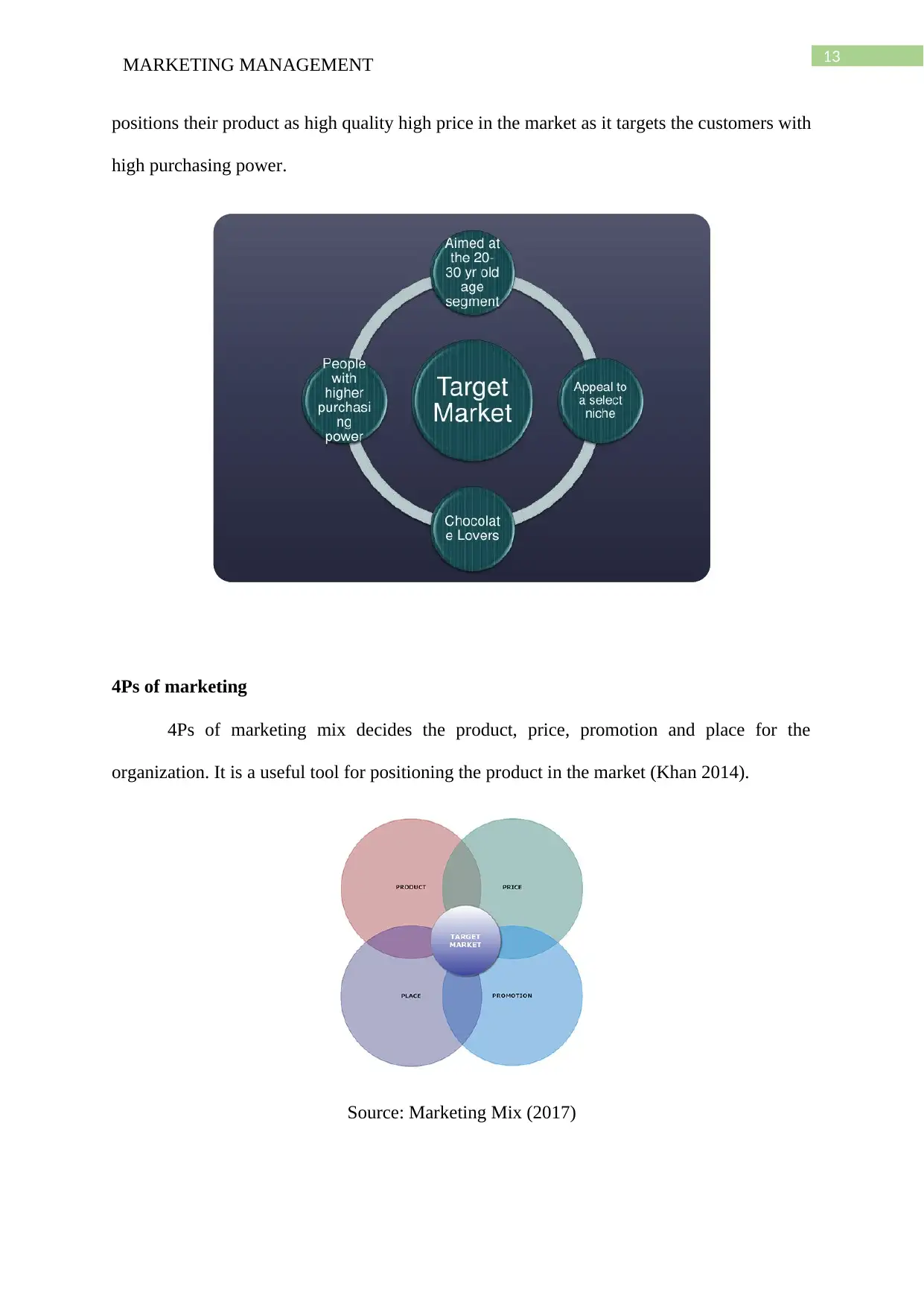
13
MARKETING MANAGEMENT
positions their product as high quality high price in the market as it targets the customers with
high purchasing power.
4Ps of marketing
4Ps of marketing mix decides the product, price, promotion and place for the
organization. It is a useful tool for positioning the product in the market (Khan 2014).
Source: Marketing Mix (2017)
MARKETING MANAGEMENT
positions their product as high quality high price in the market as it targets the customers with
high purchasing power.
4Ps of marketing
4Ps of marketing mix decides the product, price, promotion and place for the
organization. It is a useful tool for positioning the product in the market (Khan 2014).
Source: Marketing Mix (2017)
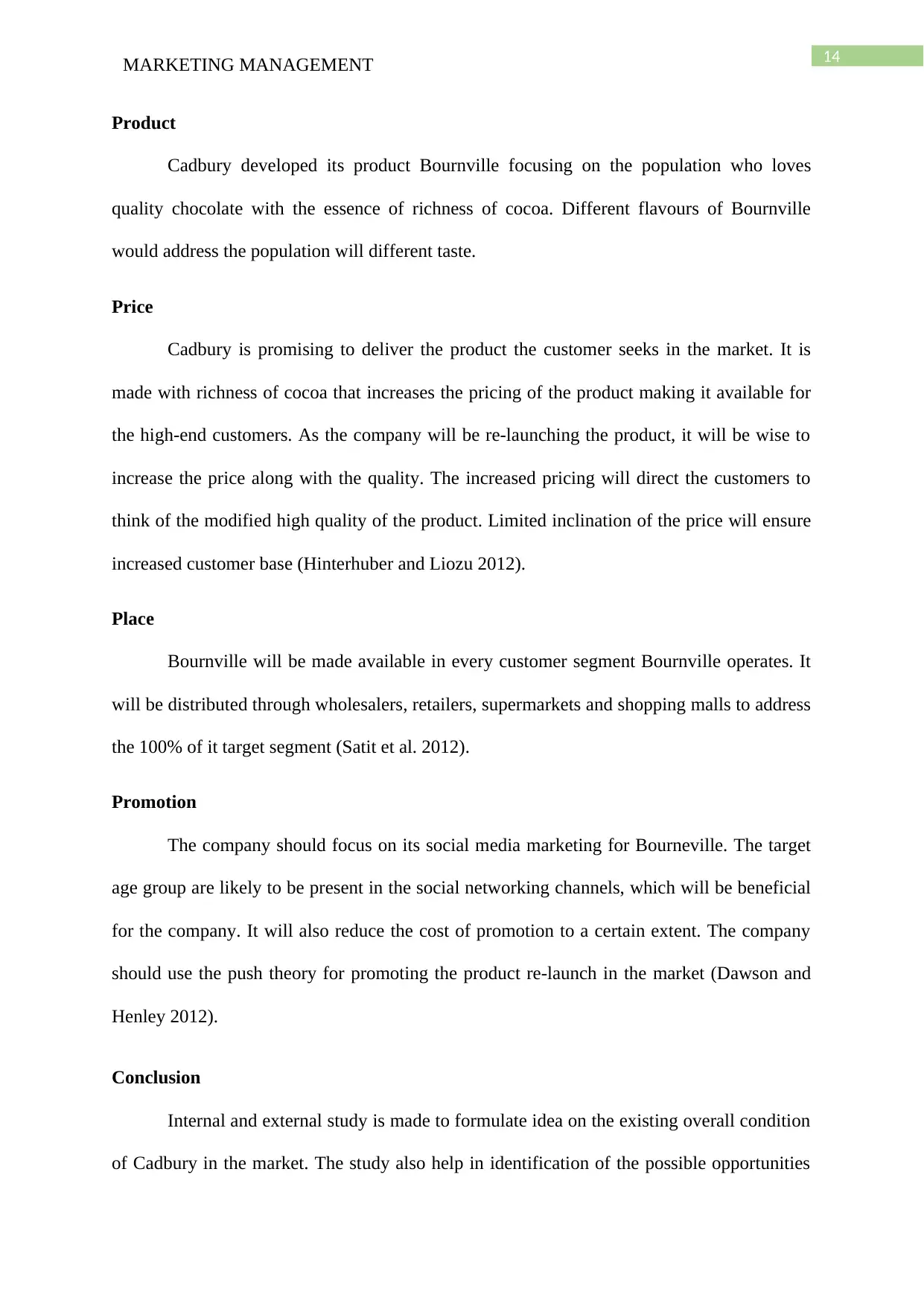
14
MARKETING MANAGEMENT
Product
Cadbury developed its product Bournville focusing on the population who loves
quality chocolate with the essence of richness of cocoa. Different flavours of Bournville
would address the population will different taste.
Price
Cadbury is promising to deliver the product the customer seeks in the market. It is
made with richness of cocoa that increases the pricing of the product making it available for
the high-end customers. As the company will be re-launching the product, it will be wise to
increase the price along with the quality. The increased pricing will direct the customers to
think of the modified high quality of the product. Limited inclination of the price will ensure
increased customer base (Hinterhuber and Liozu 2012).
Place
Bournville will be made available in every customer segment Bournville operates. It
will be distributed through wholesalers, retailers, supermarkets and shopping malls to address
the 100% of it target segment (Satit et al. 2012).
Promotion
The company should focus on its social media marketing for Bourneville. The target
age group are likely to be present in the social networking channels, which will be beneficial
for the company. It will also reduce the cost of promotion to a certain extent. The company
should use the push theory for promoting the product re-launch in the market (Dawson and
Henley 2012).
Conclusion
Internal and external study is made to formulate idea on the existing overall condition
of Cadbury in the market. The study also help in identification of the possible opportunities
MARKETING MANAGEMENT
Product
Cadbury developed its product Bournville focusing on the population who loves
quality chocolate with the essence of richness of cocoa. Different flavours of Bournville
would address the population will different taste.
Price
Cadbury is promising to deliver the product the customer seeks in the market. It is
made with richness of cocoa that increases the pricing of the product making it available for
the high-end customers. As the company will be re-launching the product, it will be wise to
increase the price along with the quality. The increased pricing will direct the customers to
think of the modified high quality of the product. Limited inclination of the price will ensure
increased customer base (Hinterhuber and Liozu 2012).
Place
Bournville will be made available in every customer segment Bournville operates. It
will be distributed through wholesalers, retailers, supermarkets and shopping malls to address
the 100% of it target segment (Satit et al. 2012).
Promotion
The company should focus on its social media marketing for Bourneville. The target
age group are likely to be present in the social networking channels, which will be beneficial
for the company. It will also reduce the cost of promotion to a certain extent. The company
should use the push theory for promoting the product re-launch in the market (Dawson and
Henley 2012).
Conclusion
Internal and external study is made to formulate idea on the existing overall condition
of Cadbury in the market. The study also help in identification of the possible opportunities
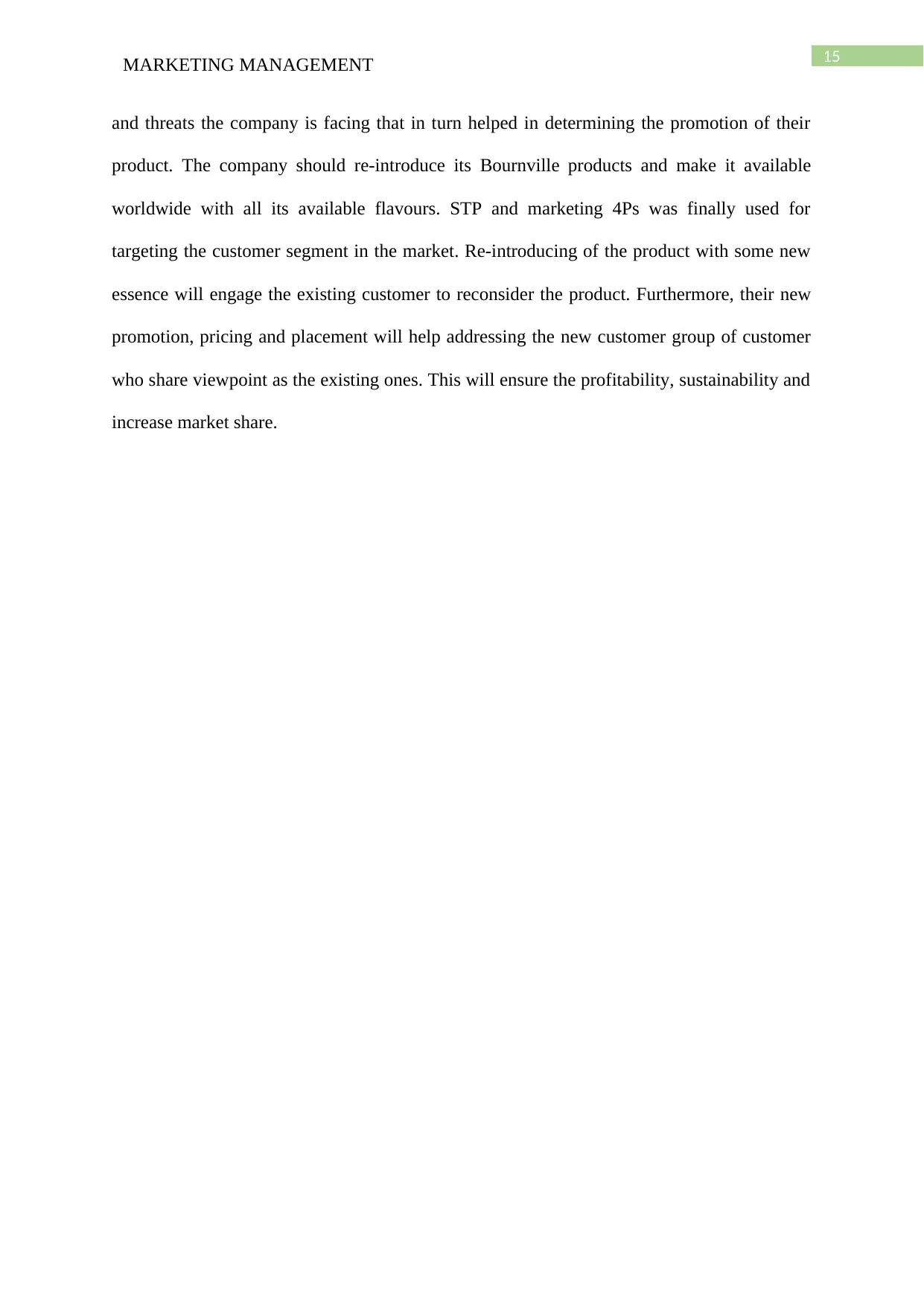
15
MARKETING MANAGEMENT
and threats the company is facing that in turn helped in determining the promotion of their
product. The company should re-introduce its Bournville products and make it available
worldwide with all its available flavours. STP and marketing 4Ps was finally used for
targeting the customer segment in the market. Re-introducing of the product with some new
essence will engage the existing customer to reconsider the product. Furthermore, their new
promotion, pricing and placement will help addressing the new customer group of customer
who share viewpoint as the existing ones. This will ensure the profitability, sustainability and
increase market share.
MARKETING MANAGEMENT
and threats the company is facing that in turn helped in determining the promotion of their
product. The company should re-introduce its Bournville products and make it available
worldwide with all its available flavours. STP and marketing 4Ps was finally used for
targeting the customer segment in the market. Re-introducing of the product with some new
essence will engage the existing customer to reconsider the product. Furthermore, their new
promotion, pricing and placement will help addressing the new customer group of customer
who share viewpoint as the existing ones. This will ensure the profitability, sustainability and
increase market share.
Secure Best Marks with AI Grader
Need help grading? Try our AI Grader for instant feedback on your assignments.
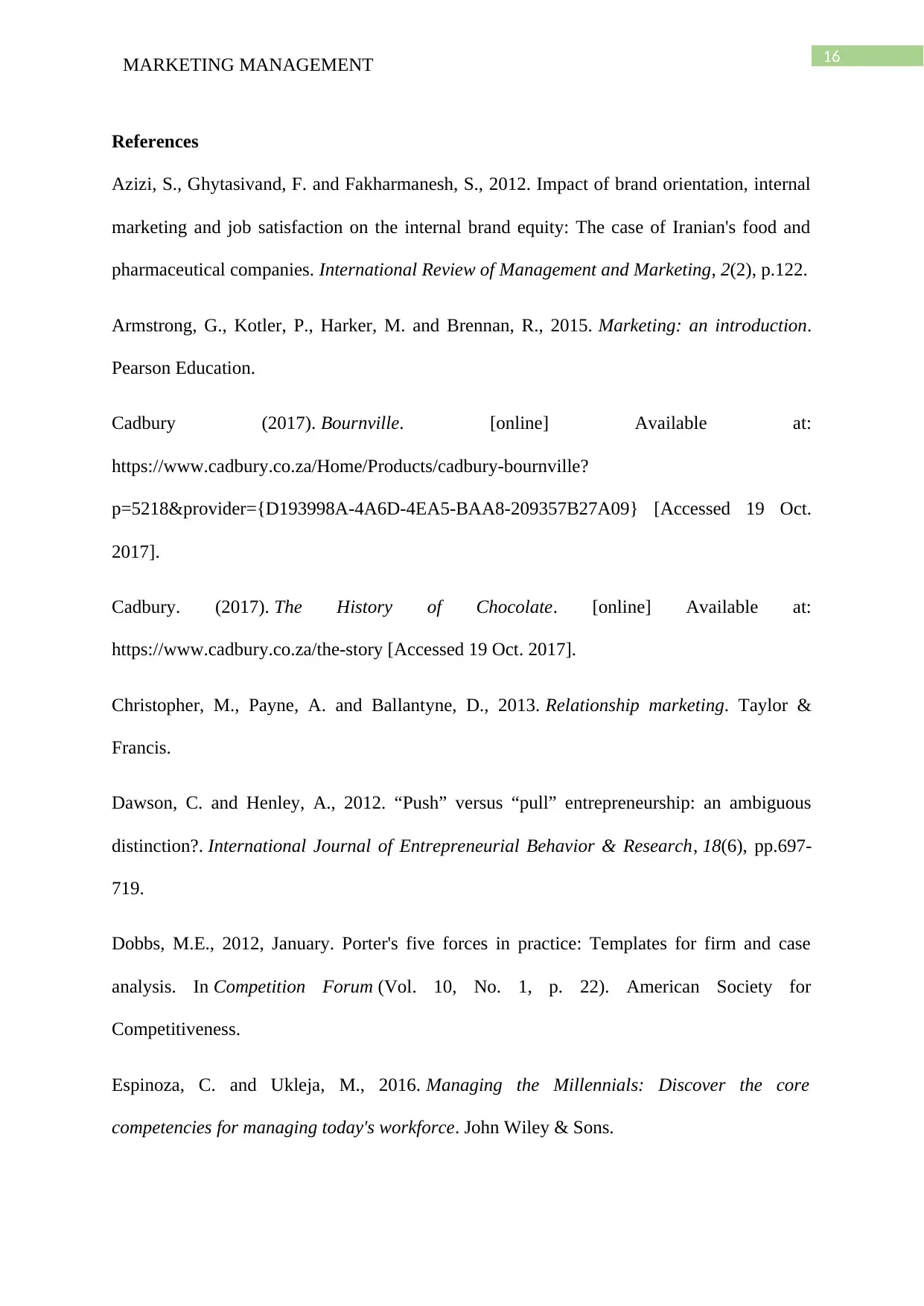
16
MARKETING MANAGEMENT
References
Azizi, S., Ghytasivand, F. and Fakharmanesh, S., 2012. Impact of brand orientation, internal
marketing and job satisfaction on the internal brand equity: The case of Iranian's food and
pharmaceutical companies. International Review of Management and Marketing, 2(2), p.122.
Armstrong, G., Kotler, P., Harker, M. and Brennan, R., 2015. Marketing: an introduction.
Pearson Education.
Cadbury (2017). Bournville. [online] Available at:
https://www.cadbury.co.za/Home/Products/cadbury-bournville?
p=5218&provider={D193998A-4A6D-4EA5-BAA8-209357B27A09} [Accessed 19 Oct.
2017].
Cadbury. (2017). The History of Chocolate. [online] Available at:
https://www.cadbury.co.za/the-story [Accessed 19 Oct. 2017].
Christopher, M., Payne, A. and Ballantyne, D., 2013. Relationship marketing. Taylor &
Francis.
Dawson, C. and Henley, A., 2012. “Push” versus “pull” entrepreneurship: an ambiguous
distinction?. International Journal of Entrepreneurial Behavior & Research, 18(6), pp.697-
719.
Dobbs, M.E., 2012, January. Porter's five forces in practice: Templates for firm and case
analysis. In Competition Forum (Vol. 10, No. 1, p. 22). American Society for
Competitiveness.
Espinoza, C. and Ukleja, M., 2016. Managing the Millennials: Discover the core
competencies for managing today's workforce. John Wiley & Sons.
MARKETING MANAGEMENT
References
Azizi, S., Ghytasivand, F. and Fakharmanesh, S., 2012. Impact of brand orientation, internal
marketing and job satisfaction on the internal brand equity: The case of Iranian's food and
pharmaceutical companies. International Review of Management and Marketing, 2(2), p.122.
Armstrong, G., Kotler, P., Harker, M. and Brennan, R., 2015. Marketing: an introduction.
Pearson Education.
Cadbury (2017). Bournville. [online] Available at:
https://www.cadbury.co.za/Home/Products/cadbury-bournville?
p=5218&provider={D193998A-4A6D-4EA5-BAA8-209357B27A09} [Accessed 19 Oct.
2017].
Cadbury. (2017). The History of Chocolate. [online] Available at:
https://www.cadbury.co.za/the-story [Accessed 19 Oct. 2017].
Christopher, M., Payne, A. and Ballantyne, D., 2013. Relationship marketing. Taylor &
Francis.
Dawson, C. and Henley, A., 2012. “Push” versus “pull” entrepreneurship: an ambiguous
distinction?. International Journal of Entrepreneurial Behavior & Research, 18(6), pp.697-
719.
Dobbs, M.E., 2012, January. Porter's five forces in practice: Templates for firm and case
analysis. In Competition Forum (Vol. 10, No. 1, p. 22). American Society for
Competitiveness.
Espinoza, C. and Ukleja, M., 2016. Managing the Millennials: Discover the core
competencies for managing today's workforce. John Wiley & Sons.
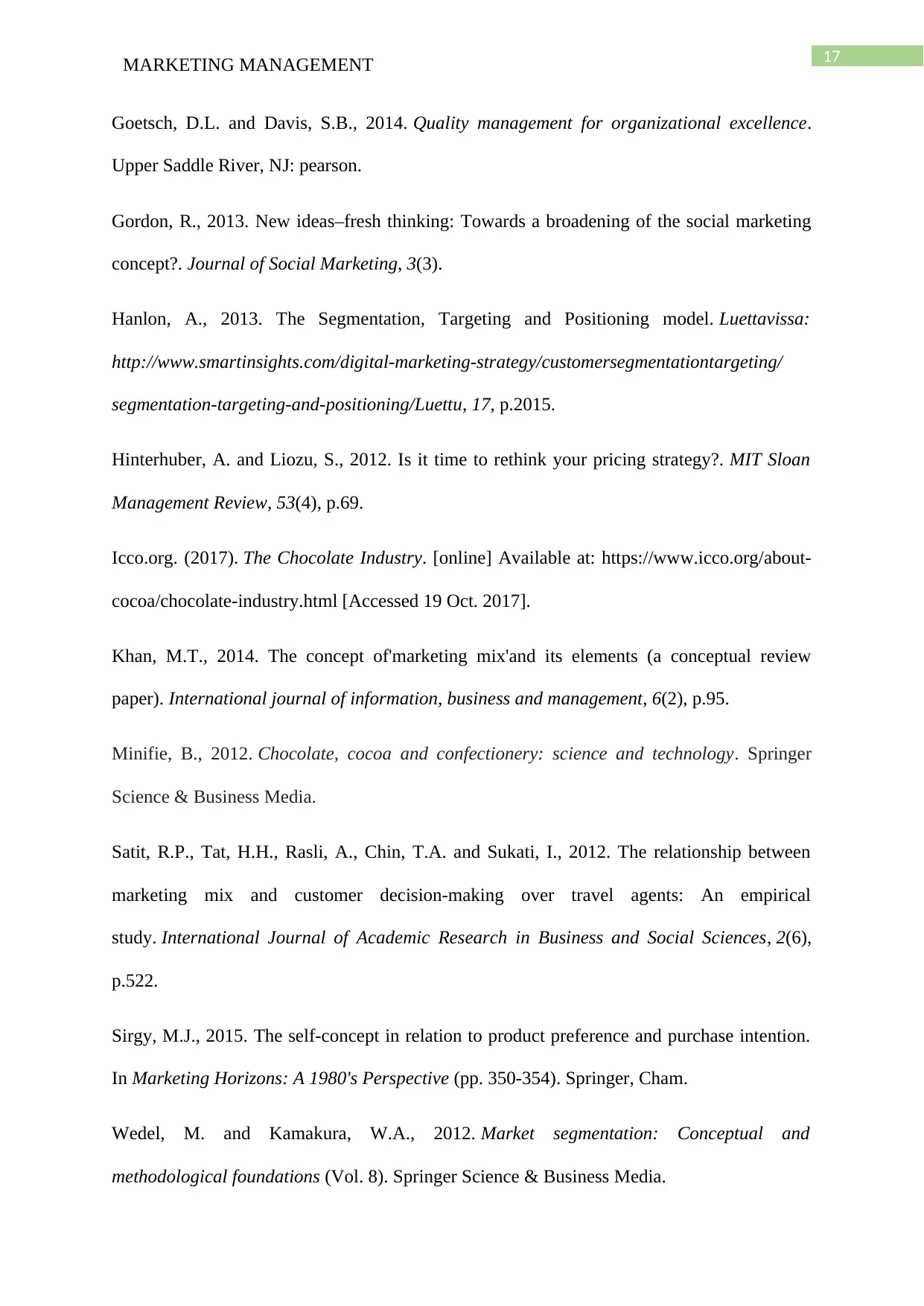
17
MARKETING MANAGEMENT
Goetsch, D.L. and Davis, S.B., 2014. Quality management for organizational excellence.
Upper Saddle River, NJ: pearson.
Gordon, R., 2013. New ideas–fresh thinking: Towards a broadening of the social marketing
concept?. Journal of Social Marketing, 3(3).
Hanlon, A., 2013. The Segmentation, Targeting and Positioning model. Luettavissa:
http://www.smartinsights.com/digital-marketing-strategy/customersegmentationtargeting/
segmentation-targeting-and-positioning/Luettu, 17, p.2015.
Hinterhuber, A. and Liozu, S., 2012. Is it time to rethink your pricing strategy?. MIT Sloan
Management Review, 53(4), p.69.
Icco.org. (2017). The Chocolate Industry. [online] Available at: https://www.icco.org/about-
cocoa/chocolate-industry.html [Accessed 19 Oct. 2017].
Khan, M.T., 2014. The concept of'marketing mix'and its elements (a conceptual review
paper). International journal of information, business and management, 6(2), p.95.
Minifie, B., 2012. Chocolate, cocoa and confectionery: science and technology. Springer
Science & Business Media.
Satit, R.P., Tat, H.H., Rasli, A., Chin, T.A. and Sukati, I., 2012. The relationship between
marketing mix and customer decision-making over travel agents: An empirical
study. International Journal of Academic Research in Business and Social Sciences, 2(6),
p.522.
Sirgy, M.J., 2015. The self-concept in relation to product preference and purchase intention.
In Marketing Horizons: A 1980's Perspective (pp. 350-354). Springer, Cham.
Wedel, M. and Kamakura, W.A., 2012. Market segmentation: Conceptual and
methodological foundations (Vol. 8). Springer Science & Business Media.
MARKETING MANAGEMENT
Goetsch, D.L. and Davis, S.B., 2014. Quality management for organizational excellence.
Upper Saddle River, NJ: pearson.
Gordon, R., 2013. New ideas–fresh thinking: Towards a broadening of the social marketing
concept?. Journal of Social Marketing, 3(3).
Hanlon, A., 2013. The Segmentation, Targeting and Positioning model. Luettavissa:
http://www.smartinsights.com/digital-marketing-strategy/customersegmentationtargeting/
segmentation-targeting-and-positioning/Luettu, 17, p.2015.
Hinterhuber, A. and Liozu, S., 2012. Is it time to rethink your pricing strategy?. MIT Sloan
Management Review, 53(4), p.69.
Icco.org. (2017). The Chocolate Industry. [online] Available at: https://www.icco.org/about-
cocoa/chocolate-industry.html [Accessed 19 Oct. 2017].
Khan, M.T., 2014. The concept of'marketing mix'and its elements (a conceptual review
paper). International journal of information, business and management, 6(2), p.95.
Minifie, B., 2012. Chocolate, cocoa and confectionery: science and technology. Springer
Science & Business Media.
Satit, R.P., Tat, H.H., Rasli, A., Chin, T.A. and Sukati, I., 2012. The relationship between
marketing mix and customer decision-making over travel agents: An empirical
study. International Journal of Academic Research in Business and Social Sciences, 2(6),
p.522.
Sirgy, M.J., 2015. The self-concept in relation to product preference and purchase intention.
In Marketing Horizons: A 1980's Perspective (pp. 350-354). Springer, Cham.
Wedel, M. and Kamakura, W.A., 2012. Market segmentation: Conceptual and
methodological foundations (Vol. 8). Springer Science & Business Media.
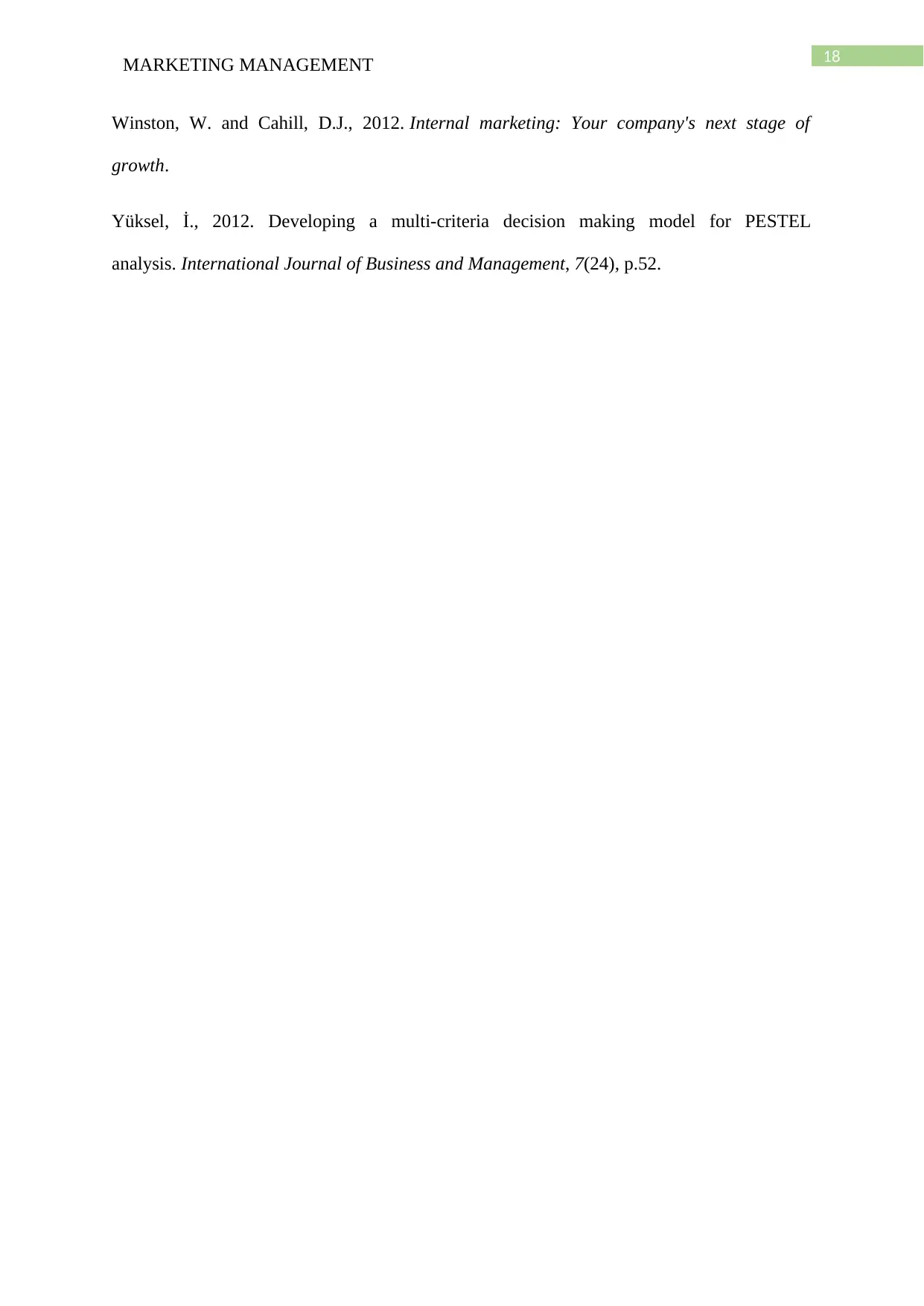
18
MARKETING MANAGEMENT
Winston, W. and Cahill, D.J., 2012. Internal marketing: Your company's next stage of
growth.
Yüksel, İ., 2012. Developing a multi-criteria decision making model for PESTEL
analysis. International Journal of Business and Management, 7(24), p.52.
MARKETING MANAGEMENT
Winston, W. and Cahill, D.J., 2012. Internal marketing: Your company's next stage of
growth.
Yüksel, İ., 2012. Developing a multi-criteria decision making model for PESTEL
analysis. International Journal of Business and Management, 7(24), p.52.
1 out of 19
Related Documents
Your All-in-One AI-Powered Toolkit for Academic Success.
+13062052269
info@desklib.com
Available 24*7 on WhatsApp / Email
![[object Object]](/_next/static/media/star-bottom.7253800d.svg)
Unlock your academic potential
© 2024 | Zucol Services PVT LTD | All rights reserved.




